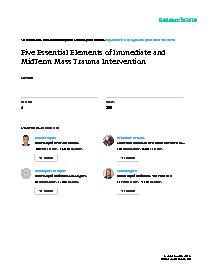Five essential elements of immediate and mid-term mass trauma intervention: empirical evidence
Abstract
Given the devastation caused by disasters and mass violence, it is critical that intervention policy be based on the most updated research findings. However, to date, no evidence–based consensus has been reached supporting a clear set of recommendations for intervention during the immediate and the mid–term post mass trauma phases. Because it is unlikely that there will be evidence in the near or mid–term future from clinical trials that cover the diversity of disaster and mass violence circumstances, we assembled a worldwide panel of experts on the study and treatment of those exposed to disaster and mass violence to extrapolate from related fields of research, and to gain consensus on intervention principles. We identified five empirically supported intervention principles that should be used to guide and inform intervention and prevention efforts at the early to mid–term stages. These are promoting: 1) a sense of safety, 2) calming, 3) a sense of self– and community efficacy, 4) connectedness, and 5) hope.
Geachte bezoeker,
De informatie die u nu opvraagt, kan door psychotraumanet niet aan u worden getoond. Dit kan verschillende redenen hebben,
waarvan (bescherming van het) auteursrecht de meeste voorkomende is. Wanneer het mogelijk is om u door te verwijzen naar de bron
van deze informatie, dan ziet u hier onder een link naar die plek.
Als er geen link staat, kunt u contact opnemen met de bibliotheek,
die u verder op weg kan helpen.
Met vriendelijke groet,
Het psychotraumanet-team.
Reference:
Stevan E. Hobfoll, Patricia Watson, Carl C. Bell, Richard A. Bryant, Melissa J. Brymer, Matthew J. Friedman, Merle Friedman, Berthold P.R. Gersons, Joop T.V.M de Jong, Christopher M. Layne, Shira Maguen, Yuval Neria, Ann E. Norwood, Robert S. Pynoos, Dori Reissman, Josef I. Ruzek, Arieh Y. Shalev, Zahava Solomon, Alan M. Steinberg, & Robert J. Ursano | 2007
In: Psychiatry, ISSN 0033-2747 | 70 | 4 | 283-315
http://www.tandfonline.com/doi/abs/10.1521/psyc.2007.70.4.283
In: Psychiatry, ISSN 0033-2747 | 70 | 4 | 283-315
http://www.tandfonline.com/doi/abs/10.1521/psyc.2007.70.4.283


